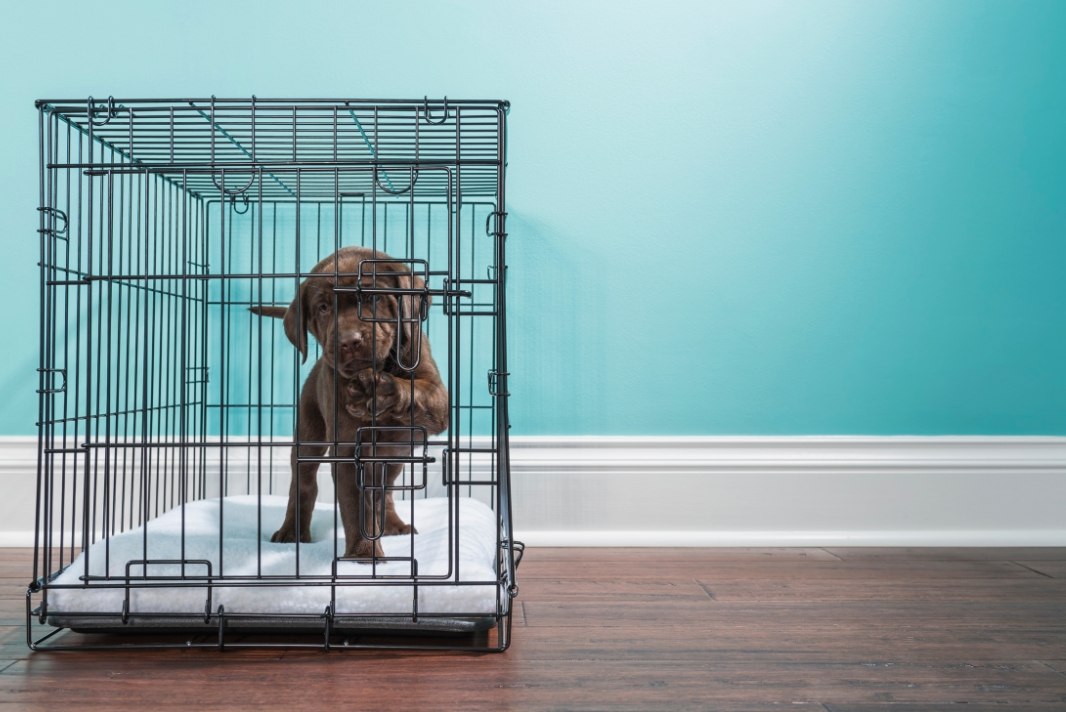Using a crate can be one of the greatest tools to use in raising your puppy! But it becomes not-so-great if your pup can’t seem to settle down and relax when they’re in there and bark, cry or whine instead. Here’s some tips to calm your puppy during crate time!
Crates provide a safe place for our puppies, promote independence and can help speed up the potty training process. Plus dogs are den animals! So they find great comfort in cozy spaces.
But what happens when your puppy just can’t seem to settle down and relax when they’re in their crate? Here are the top reasons why we see clients struggling with crate training and tips to help change that for good!
Reason #1 your puppy isn’t calm in the crate: You’re Only Crating Them At Night or When You Leave
One of the reasons your puppy may not be taking to their crate could be if you’re only putting then in there at night, or when you leave them home alone.
Nighttime is not enough and consistency is needed during the daytime as well. Plus if you only crate them when you leave, they’re now associating them being in the crate with you being gone, which can create anxiety with it and have them start to build a negative association with being in the crate that comes out in barking, whining and crying while you’re away.
TIP: Include a crate rotation as part of your daytime schedule with your puppy, even when you are home, to teach them independence. For a sample daily puppy schedule, check out our blog Create a Daily Schedule for Your Puppy.
Reason #2 your puppy isn’t calm in the crate: You’re Accidentally Amping Them Up Before They Go In
Something else you may not be realizing you’re doing is amping your puppy up in a physical or emotional way right before you’re putting them in their crate.
For example, if you’re playing with and get them really riled up, putting them in the crate immediately after without a chance to de-escalate and calm down can make it much more difficult for them to settle. Similarly if you’re emotionally doing this – this often happens in terms of affection, like cuddling, snuggling and petting them – then putting them in the crate, they will often likely be unable to calm quickly.
TIP: When you separate yourself from them, everything should be transitioned. Your puppy needs to be in a calm state of mind before you put them in crate, whenever possible. To do this, work your puppy calmly through some simple obedience commands, or just ignore them for a while, before you calmly put them in their crate.
Reason #3 your puppy isn’t calm in the crate: Your Puppy Has Too Much Energy
Another reason your puppy may not be able to relax in their crate is they’re not getting enough exercise or the right type of exercise. This doesn’t just mean physical activity; we actually mean more mental exercises.
Incorporating enrichment exercises in your puppy’s daily life that works them mentally will help them release their energy in productive ways, while feeling more fulfilled.
TIP: Practice daily training sessions incorporating not just obedience commands, but more challenging impulse control work as well. For example, waiting for permission to go through thresholds, and for their food bowl.
Reason #4 your puppy isn’t calm in the crate: Your Puppy May Be Getting Too Much Attention & Affection When They’re Out Of Crate
This one’s a tough one! As much as we want to love on our puppies as much as possible, having a good balance and making sure your puppy gets some alone time is crucial to their development, including how they respond when they’re in crate!
Puppies that get so used to having us around them all the time often develop separation anxiety, which could show itself as barking, whining, crying and even panicking when they are left by themselves.
TIP: When following your daily puppy schedule for their scheduled alone time, place their crate in a separate room from you and the family so they get used to being without you for periods of time. For more help on preventing and fixing separation anxiety check out out blog How to Deal with Separation Anxiety in Puppies.
Do you want to know the simple routines you can use to further help your puppy be calm in their crate?
The Puppy Academy Online School walks you through easy activities you can incorporate in your daily life that will fulfill your pup, while teaching them awesome skills – yes, including how to be calm in their crate!
For more info and to sign up today, check out The Puppy Academy Online School here!
Lastly, don’t forget that the crate is NEVER to be used as a form of punishment for your puppy. It is their sacred safe place, and it should be respected as such. Always be mindful of your own energy and feelings you have about putting your puppy in the crate -- your puppy can sense these things!
We are huge fans of using a crate during puppyhood, when it’s used correctly, and we know you’ll be too once you see the huge benefits it brings as well as how much pups actually do love their own space! In fact, many of our clients choose to keep their pup’s crate throughout their entire lives because of how much their pups enjoy it. So it’s something you can consider using for a short time, or as long as you want!
If you have questions about crating help with your puppy, ask our trainers! Join our live Q&As every Wednesday at 1 pm PT on our Instagram @thepuppyacademy!
And join our Very Important Puppy list to receive puppy training tips right to your inbox every week!
Check out these related blogs on puppy training and more!
Why and How to Crate Train Your Puppy!



